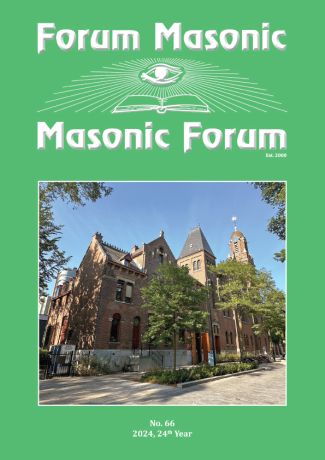GHEORGHE BELEAN
Worshipful Master, Andrei Mureșianu Lodge No.252, Bucharest
 The idea of organizing, in November 2013, of the International Symposium Câmpulung Muscel – Hearth of Medieval Cutlure, Hearh of Romanian Masonry was born on the occasion of a common meeting to which a large number of Brethren participated, from the Lodges: Andrei Mureșianu no. 252, from Bucharest, Radu Negru no. 253, from Câmpulung, Armonia no. 174 from Pitesti, and Viitorul Sf. Ioan from Vienna, Austria. Edward Frost, Past WM of Viitorul Sf Ioan Lodge from Vienna, was profoundly impressed with the legendary past of the area and especially of the Câmpulung Muscel. His urging was that we continue to meet in this formula as well. When you see such enthusiasm from a Brother from abroad, there is nothing left to do but to pick up the chisel, the hammer and the plumb line and to begin a Masonic construction that would endure in time. So this is how the idea of the symposium was born. A state of harmony, the communion of ideas and Masonic experiences of great intensity. Trump cards? I think we can speak of a different approach to communication. A larger opening at the level of the base of the Obedience, a better knowledge in-between the Brethren, between Lodges; the desire to organize common projects.
The idea of organizing, in November 2013, of the International Symposium Câmpulung Muscel – Hearth of Medieval Cutlure, Hearh of Romanian Masonry was born on the occasion of a common meeting to which a large number of Brethren participated, from the Lodges: Andrei Mureșianu no. 252, from Bucharest, Radu Negru no. 253, from Câmpulung, Armonia no. 174 from Pitesti, and Viitorul Sf. Ioan from Vienna, Austria. Edward Frost, Past WM of Viitorul Sf Ioan Lodge from Vienna, was profoundly impressed with the legendary past of the area and especially of the Câmpulung Muscel. His urging was that we continue to meet in this formula as well. When you see such enthusiasm from a Brother from abroad, there is nothing left to do but to pick up the chisel, the hammer and the plumb line and to begin a Masonic construction that would endure in time. So this is how the idea of the symposium was born. A state of harmony, the communion of ideas and Masonic experiences of great intensity. Trump cards? I think we can speak of a different approach to communication. A larger opening at the level of the base of the Obedience, a better knowledge in-between the Brethren, between Lodges; the desire to organize common projects.
Câmpulung Muscel is a settlement created on the model of the unification of communes, a land that would later become the Commune of the proud freeholders of Campulung. From antiquity, the name of the town was inseparably connected to Radu Negru, Mihai Voievod – the son of Mircea cel Bătrân, Matei Basarab and many others. In 1500, we have the first document bearing witness to the township. Here, the first books were printed in Romanian, as well as other books of note at that time: The Slavic Prayer Book, The teaching for all days, The Slavic Book of Wakes and The Celebrations of All the Saints, The Slavic Psalm book. This is where the Canvas of Câmpulung was put together, a precious collection of charters and documents written between 1559-1747.
In 1880, Negru Vodă Lodge was found in Câmpulung. From the beginning, three conditions were fulfilled:
– the strength Brethren who had some activity in masonry, these being teachers, professors, military cadres, merchants.
– their wisdom, as they were men of culture, priests and pedagogues.
– their beauty, expressed in the Black Eagle, that is to say “the eagle which eats snakes”, featured on the escutcheon of the Basarab family, but also on the escutcheon of the city. Then, there is the Negru Vodă Monastery, a place with high Masonic specifications, the Monastery at Nămoești – known through the Eye from Nămoești and the Flagstone from Nămoești.
I rejoice to have ascertained that many of participants have catalogued without reservations the academic standing, the papers presented in the magazine of the symposium. As for the theme, what can I say? This wonderful land is one of the ancestral hearths of the Romanian nation. It was the first capital of the Wallachian principality. Among the plethora of great personalities of the Romanian culture and of Masonry who were born and raised there, we mention: I.D. Negulici, C.D. Aricescu, Dumitru Vianu, Ioan Paleologu, the painter Teodor Aman, the engineer Mathei Draghicenu, the poet Dimitrie Nanu, the mathematician and poet Ion Barbu, the sculptor Dimitrie Mirea.
With the support of W.Bro. Claudiu Ionescu, director of the Masonic Forum Magazine, on the model of Forum, we have edited a bilingual journal in which were included all the papers presented at the symposium
If at the first edition we had 109 participants, in 2014 there will be 150-200 participants. May the Brethren who will participate in the Second Edition feast on the beauty of these wonderful lands, to participate in an act of Masonic construction of a high deportment, and may all of us leave that place with our souls full of hope, harmony, peace and balance, which should rule over us care and guide our steps.

















